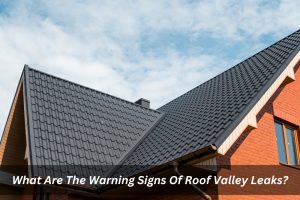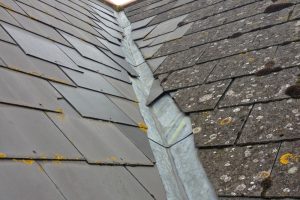For more information on any of the services offered by High Class Roofing or a free no obligation quotation, please complete the following form or call us on 0405 229 765.
What Are The Warning Signs Of Roof Valley Leaks?

Your roof is your home’s first line of defence against the elements. But what about the valleys where two roof sections meet? These crucial areas, known as roof valleys, channel rainwater away from your house. However, roof valley leaks can be a real headache for homeowners. Early detection is key to preventing extensive damage, so understanding the warning signs is vital.
What is a roof valley?
A roof valley is a V-shaped intersection where two sloping sections of your roof meet. It’s a vital component, directing water flow towards your gutters and preventing it from pooling on your roof. Roof valleys are typically lined with an underlayment material and flashing – a thin sheet of metal – to ensure a watertight seal.
How can you spot leaks in your roof valley?
Unfortunately, roof valley leaks aren’t always as obvious as a dripping ceiling. Here’s what to look for inside and outside your house:
Inside the house:
- Stains on ceilings and walls: Water leaking from the roof valley can travel down internal structures and manifest as brown or discoloured patches on your ceilings or walls, particularly near the eaves (where the roof overhangs the walls).
- Visible mould growth: Mould thrives in damp environments. If you notice mould patches on your ceilings or walls near the roof valley, it could indicate a leak.
- Musty odours: A damp, musty smell can sometimes be a telltale sign of a hidden leak, especially if it intensifies after heavy rain.

Outside the house:
- Damaged flashing: Flashing around the roof valley is crucial for waterproofing. Check for any signs of damage to the flashing, such as rust, cracks, or loose sections.
- Missing shingles or tiles: Shingles and tiles that are missing, damaged, or curled up near the roof valley can create gaps for water to seep through.
- Debris buildup: Leaves, twigs, and other debris can accumulate in the roof valley, blocking the flow of water and causing it to back up under the shingles or tiles.
- Sagging roof sections: In severe cases, a roof valley leak can lead to water damage that weakens the roof structure, causing sections to sag or become visibly uneven.
Should you check your attic for signs of leaks?
Absolutely! Your attic can often reveal signs of roof valley leaks before they become apparent inside your living areas. Look for moisture on roof rafters, mould growth near the valley area, or water stains on the underside of the roof sheathing.
When should you call a roofer about a roof valley leak?
If you notice any of the warning signs mentioned above, don’t hesitate to call a qualified roofer. Early detection and repair of roof valley leaks can save you from costly repairs down the track. A professional roofer can locate the source of the leak, assess the damage, and recommend the best course of action for repair. Remember, a roof valley leak left unrepaired can quickly worsen, leading to:
- Extensive water damage: Leaking water can travel through your roof structure and into your walls, ceilings, and even down to your attic. This can cause significant damage to your property, requiring costly repairs to replace drywall, insulation, and potentially even electrical wiring.
- Mould growth: Moisture from a leak creates a perfect breeding ground for mould, which can pose serious health risks to your family. Removing mould can be expensive and requires professional remediation.
- Structural damage: In severe cases, a neglected leak can compromise the structural integrity of your roof, leading to sagging, buckling, and potentially even a roof collapse. This scenario necessitates a major and very expensive roof repair or even a complete roof replacement.
How can you prevent roof valley leaks?
Roof valleys are crucial for channelling rainwater away from your home, but they’re also vulnerable to leaks. Here’s how proactive maintenance can minimise the risk of costly repairs:
- Schedule regular inspections: Don’t wait for leaks to spring a surprise. Get your roof inspected by a qualified professional at least twice a year, ideally before the wet season. This allows them to identify potential problems early on, such as loose flashing, worn shingles, or accumulating debris in the valleys. Addressing these issues promptly prevents them from escalating into leaks.
- Clear your roof valleys: Debris like leaves, twigs, and moss can act like a dam, trapping water in the valleys. Regularly clear these obstructions to ensure smooth water flow. Use a garden hose with a gentle spray setting to dislodge debris, but exercise caution when working at heights. Consider using a roof rake for added safety.
- Prioritise proper maintenance: Regular maintenance goes a long way in preventing leaks. This may involve tasks like:
- Re-sealing flashing: Flashing, the thin metal sheet lining the valleys, provides an extra layer of waterproofing. Over time, the sealant around the flashing can deteriorate. A qualified roofer can assess its condition and re-seal it if necessary.
- Replacing damaged shingles: Shingles in the valley are particularly exposed to wear and tear. During inspections, your roofer will identify cracked or missing shingles and replace them to maintain a watertight seal.
- Addressing minor issues: Don’t ignore minor issues like loose nails or chipped shingles. A professional roofer can address them promptly, preventing them from developing into major leaks later.
By incorporating these preventative measures into your home maintenance routine, you can ensure your roof valleys function optimally, protecting your home from potential water damage and costly repairs.
Conclusion
Roof valley leaks can be a sneaky problem, but with a bit of knowledge and vigilance, you can identify them early and prevent major issues. Remember, a healthy roof is a vital part of a healthy home, so don’t ignore any signs that something might be amiss.
For a free roof inspection and expert advice on preventing roof valley leaks, contact High Class Roofing today. Our team of qualified and experienced roofers will ensure your roof is in top shape, using only top-quality materials and adhering to the highest safety standards. We offer competitive rates and exceptional customer service, focusing on a stress-free experience throughout the entire process. Let us give your roof the expert care it deserves, guaranteeing long-lasting protection for your home.

